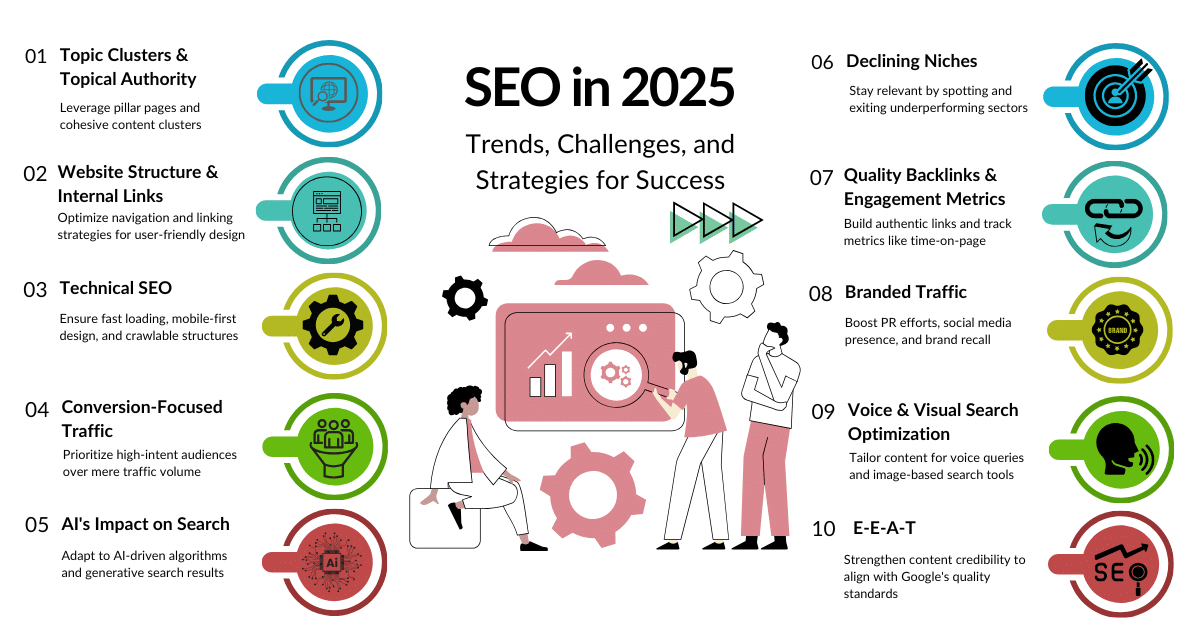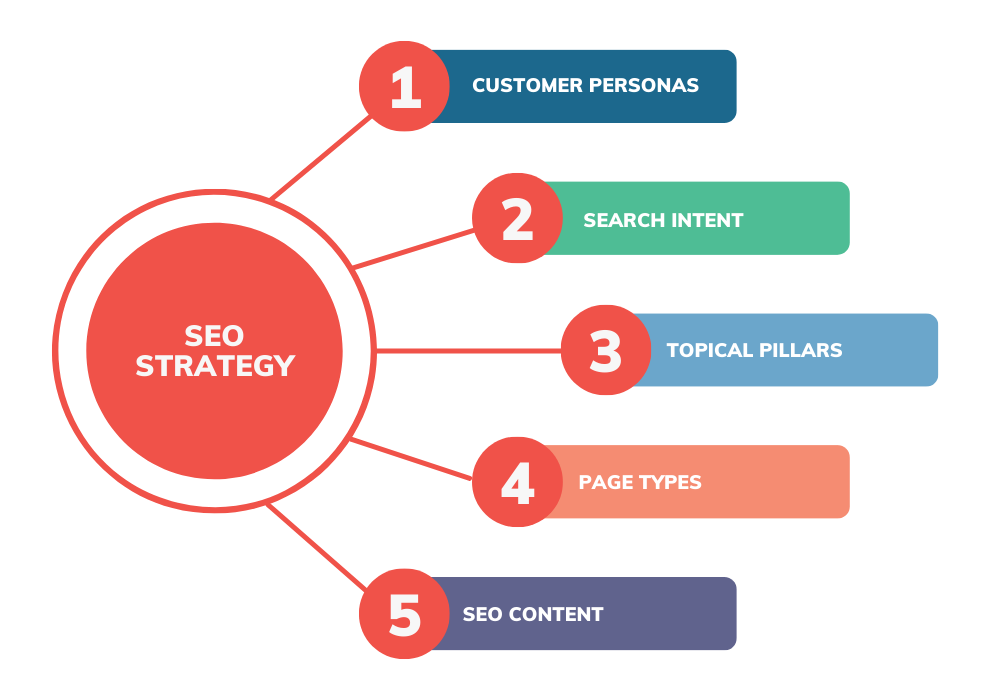In the digital age, the success of a business cannot be imagined without online visibility. There are about 8.5 billion Google searches every day. Users find answers from websites that appear on the first page of the search engine. That’s why Search Engine Optimization (SEO) today is not just a strategy but a battle for survival.
Experts say that SEO has changed significantly in 2025. It’s no longer just about using keywords—AI, technology, content, and user experience must now be integrated together.
On-Page SEO: Content is the King
Keyword Optimization
In addition to the main keyword, your content should naturally include related words (LSI and NLP entities). These keywords should appear in titles, headings, meta tags, and the first 100 words of your content to improve your site’s relevance and visibility.
Meta Tags
The click-through rate (CTR) increases when you write catchy titles and descriptions. Your meta titles should be short, intriguing, and relevant to your content, as they directly affect your SERP position.
Content Structure
Structure your content for easy readability. Use short paragraphs, lists, tables, and FAQ sections. This not only improves user engagement but also helps your site rank better on Google by making it more accessible to users.
Image Optimization
Optimizing images is now a must. Use ALT tags, compressed images, and the WebP format. Optimized images improve page load speed and help your site perform better in image searches.
Schema Markup
Add schema markup to your web pages (such as FAQ, Article, and LocalBusiness schema). This helps your content appear as rich snippets in search results, which makes it easier for users to find and engage with.
The Secret Strength of Core Web Vitals for SEO
Core Web Vitals Metrics
Google is now focusing on three important metrics in Core Web Vitals:
- LCP (Largest Contentful Paint): The time it takes for the largest piece of material on a page to show up.
- CLS (Cumulative Layout Shift): This measures how stable the parts of a page are (i.e., how much content moves).
- FID (First Input Delay): The time it takes for a page to become interactive.
Improving these numbers is vital for enhancing the user experience and boosting your SEO ranking.
Mobile-First Design
With 70% of searches now coming from mobile devices, a mobile-responsive design is essential. Google uses mobile-first indexing, which means mobile versions of your site will rank higher.
HTTPS
An insecure website is no longer trusted by users or search engines. HTTPS (for secure websites) is now a ranking factor. Ensure your website uses SSL encryption to protect user data.
Sitemaps and Robots.txt
Properly configure sitemaps and robots.txt files so that search engines can crawl and index your content effectively.
Canonical Tags
Use canonical tags to signal the original version of a page and avoid issues with duplicate content.
Content Strategy: Winning the Mind of the User
E-E-A-T Principles
Google’s E-E-A-T (Experience, Expertise, Authoritativeness, Trustworthiness) is essential for ranking in 2025. Ensure that the sources you use for your content are credible and of high quality. Author profiles and references are important for building trust with both Google and your audience.
Pillar Content + Cluster
Create pillar content (large, in-depth articles) and link them to smaller, related pieces on cluster pages. This structure helps search engines recognize topic authority and rewards you with higher rankings.
AEO (Answer Engine Optimization)
As AI-powered search engines like ChatGPT, Google SGE, and Bing Copilot become more dominant, optimizing your content for short, informative answers is crucial for appearing in AI-generated search results.
Content Update
Google loves fresh content. Regularly update your existing articles with new statistics, current events, and other relevant data to keep them relevant and ranked.
Off-Page SEO: The Reputation of the Outside World
Backlinks
Getting quality backlinks from authoritative and niche-relevant websites remains one of the most important aspects of SEO. Backlinks act as votes of confidence from other sites, directly affecting your SERP ranking.
Digital PR
Increase your brand authority by securing guest posts, news coverage, and interviews with reputable media outlets. A strong digital PR strategy helps you earn quality backlinks and visibility.
Social Signals
When your content is shared on social media, search engines take it as a sign that your content is valuable. This social activity can help improve your search rankings.
Local Citation
For local businesses, ensure that your NAP (name, address, phone number) is consistent across local directories and Google Maps. This boosts your local SEO and makes it easier for users to find you.
User Experience (UX): Improving Website Interaction
Increase CTR.
Your meta title and description should be engaging and clearly explain the value users will get from your content. The more compelling your meta tags are, the higher your click-through rate will be.
Dwell Time
Increase user engagement by adding interactive elements like quizzes, videos, and infographics. This reduces bounce rates and improves engagement, which are crucial for SEO.
Easy Navigation
Ensure your website has a clear menu, breadcrumbs, and a search bar that is easy to find and use. Good navigation ensures users stay engaged and want to explore more pages.
SEO for the Local Market
Google Business Profile
Regularly update your Google Business Profile with fresh photos, posts, and Q&A to engage with local customers and improve your local rankings.
Local Keywords
Integrate city and region names into your content to improve local SEO. This will help your site appear in location-based searches.
Review Management
Encourage users to leave reviews and always respond to them. Managing reviews is an important ranking factor in local SEO, and good reviews can significantly boost your rankings.
A Better SEO Strategy: Enhanced for 2025
Programmatic SEO
Automatically create hundreds of location-based pages or product pages to scale your SEO efforts. This is especially useful for businesses with multiple locations or e-commerce platforms.
Video SEO
Optimize YouTube titles, tags, and subtitles to rank higher in Google and YouTube searches. Video content remains a strong ranking factor in 2025.
Voice Search Optimization
As voice search becomes more prevalent, optimize your site for conversational keywords like “near me,” “how to,” and “where to find.” Voice search is becoming more integrated into daily life, and optimizing for it can provide a competitive edge.
Generative Engine Optimization (GEO)
With the rise of generative AI search engines like ChatGPT, it’s essential to provide short, informative, and formulaic answers that can be easily processed by AI search engines.
Conclusion
SEO isn’t just for search engines anymore. It’s about providing the best user experience, creating high-quality content, and ensuring your website is technologically optimized. Websites that load quickly, offer useful information, and are easy to navigate will naturally rank higher in search results.
In summary:
Technical SEO + Quality Content + Strong Backlinks + Great UX = Long-Term Success




